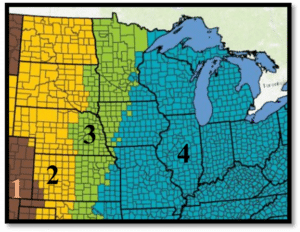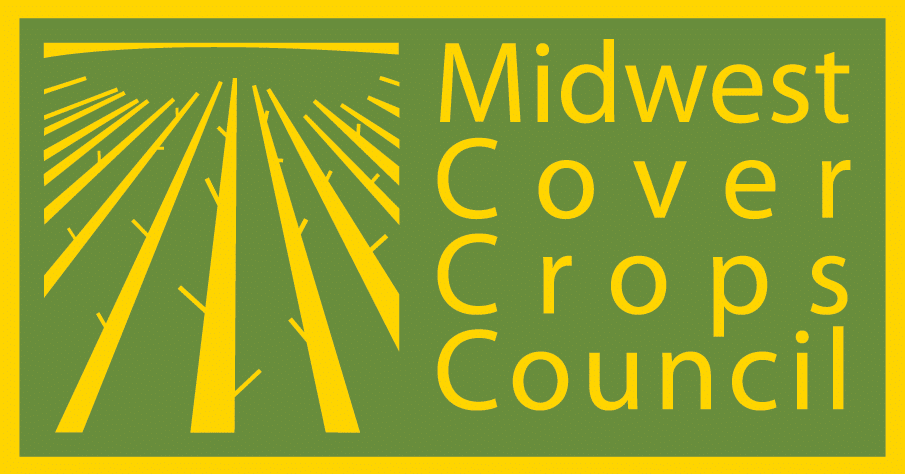Termination
Termination is an important factor in planning and executing your cover crop. Cultural, chemical, and mechanical options are available to terminate cover crops prior to planting the next cash crop; below is the latest information from around the Midwest. Please see the bottom of the page for information on important nitrogen management concerns and planting green.
Managing Cover Crop Profitably (SARE Handbook Series Book 9) by Andy Clark (2007, 3rd ed.) is a good resource for getting started with cover crops.
Strategies/Timing
To the right is the different strategies for timing cover crop termination. It is generally preferable to start with Plan A, though other plans may be better suited to specific purposes or unfavorable weather conditions. See the full NRCS zone map here.

Plan A is usually preferable, especially before planting corn. For farmers new to growing cover crops, the MCCC recommends terminating cover crops either two weeks before planting the next crop, or when the cover crops are 6 to 12 inches tall, whichever occurs first. With experience, farmers may find they can maximize benefits by terminating later. To address more specific cover crop purposes such as weed control, or for very wet springs when early termination is not possible, see plans B, C, and D.
Spray herbicides 1-2 days before planting the cash crop. For corn, we recommend applying starter N or early sidedress N . See important management considerations below.
Advantages:
Herbicide works effectively on undamaged plants. Cover crop starts dying before the cash crop is planted.
Disadvantages:
If it rains after spraying but before planting, planting may be further delayed, and large cover crops may form a wet mat that interferes with planter/drill performance. Traffic ahead of planting can orient or lean tall cover crop residue against the planting direction which can cause planter/drill operation issues.
Spray herbicides before planting the cash crop, up to the day of planting. For corn, we recommend applying starter N or sidedress N as soon as possible. See important management considerations below.
Advantages:
Herbicide works effectively on undamaged plants. Cover crop starts dying before the cash crop is planted.
Disadvantages:
If it rains after spraying but before planting, planting may be further delayed, and large cover crops may form a wet mat that interferes with planter/drill performance.
Spray herbicides after planting the cash crop (on the same day or within 1-2 days). For corn, we recommend applying starter N or early sidedress N . See important management considerations below.
Advantages:
Planter/drill performance is better in the standing cover crop.
Disadvantages:
If it rains after planting but before herbicide application, there is a risk the cash crop will emerge before the application. If that happens, there are fewer options for killing the cover crop, and there is a potential for yield loss due to early-season competition.
If unable to execute plan C, and the insured crop has emerged, spray herbicides as soon as possible. For corn, we recommend applying sidedress N as soon as possible. See important management considerations below.
Advantages:
The cash crop is planted, and yield loss from delayed planting is avoided.
Disadvantages:
There are fewer options for killing the cover crop, and there is a potential for yield loss due to early-season competition.
Termination types
Terminating with translocated herbicides is much more effective with warm temperatures and when the cover crop is actively growing. Nonselective, contact herbicides can also be effective depending on cover crop size and growth stage.
For optimal control, some cover crop species may require a second herbicide application two to three weeks after the initial one. You can combine this second application with residual herbicides to improve weed control in the succeeding crop.
If you use an herbicide to terminate a cover crop, always consult the product label and your state or provincial weed control guide first. These local guides provide the most current legal and effective herbicides for your location and cropping system.
Access to your own spray equipment or good communication of the herbicide plan with the applicator is important to ensure good timing of application with consideration of environmental conditions.
Consult your state or provincial resources for more details on the effective use of herbicides in early spring.
Things to consider when applying herbicides:
- Spray water quality and conditioning, adjuvants, and tank mixes. See: Impact of water quality on pesticide performance
- Nozzles and spray volume. See: Sprayer Nozzle Know-How
- Air temperature. See: How Temperature and Rain Can Affect Burndown Herbicides and Temperature and Herbicide Application Questions
- Time of Day.
Glyphosate specific information on the considerations listed above available here: Understanding Glyphosate to Increase Performance - Purdue Extension
If you use herbicides to terminate a cover crop, always consult the product label and your state or provincial weed control guide first. These local guides provide the most current legal and effective herbicides for your location and cropping system.
Find weed control guides for your state or province here.
Frost or extended periods of freezing will usually terminate warm-season and certain cool season cover crops such as buckwheat, oat, and radish. However, chemical or mechanical methods may be required to terminate winter hardy cover crops such as rye, ryegrass, and hairy vetch.
Using tillage to terminate cover crops can be accomplished in conjunction with other mechanical or chemical methods or as a standalone method. A moldboard plow, heavy disk or specialized combination tools may be used depending on the biomass accumulation and desired cover crop surface residue needed to meet the growers’ objectives. The termination and incorporation of green biomass that usually consists of higher tonnage and higher protein (Nitrogen) composition is often referred to as “green manuring”. Since this green biomass is a quality food source for soil biota, it can provide more rapid carbon and nutrient cycling which speeds the release of plant available nutrients and a temporary increase in important soil functions. These short-term gains can be at the expense of soil surface armor, habitat for beneficial organisms, and long-term improvements in soil structure and soil functions especially if tillage becomes annual standard operating procedure for termination. When tillage termination is planned, it is generally advantageous for soil health to allow significant biomass accumulation. Be aware that concentrations of incorporated cover crop biomass in and around the cash crop seeding depth zone can be detrimental to germinating seeds when the cover crop biomass contains allelochemicals, host traits for pathogens, or create an uneven seed bed.
Mechanical methods are also effective ways to terminate cover crops. Mowing, can successfully control some cover crops at the flowering or heading stage. Using a moldboard plow or heavy disc can control cover crops very effectively and increase the rate of N availability from legume cover crops, although it leaves the soil surface vulnerable to erosion and oxidizes soil organic matter.
Grazing alone is generally insufficient to terminate cover crops and is not an acceptable termination method for crop insurance purposes. Consult your local extension service or conservation agency for grazing considerations with cover crops. Be sure to follow herbicide restrictions for cover crops intended to be grazed.
Using a roller crimper can successfully control some cover crops at the flowering or heading stage. For optimal control with a roller crimper, you need to crush the stems of cover crops rather than bend them. Be aware that roller crimping is an advanced termination strategy that requires careful management. For more information on roller crimping, you can visit the following:
Important Nitrogen Management Concerns
We recommend applying starter N at planting for corn, especially when considerable cover crop residue is present. Most cover crops are early users of soil-available nitrogen, so starter N can offset this early immobilization.
Cover crop residue with a high carbon to nitrogen (C:N) ratio can further reduce soil N availability to meet a corn crop’s high N demand. Grasses and cover crop mixes with grasses have a high C:N ratio, making it very important to add starter N in these systems or to sidedress N early in the season. The cover crop’s maturity and species (and the weather) will affect N availability for the growing cash crop.
Planting Green
Planting green is a term used when producers plant a cash crop directly into a standing cover crop that is still green. In such cases, producers typically terminate the cover crop within a day or two before or after planting. Consider this method a higher management option that will require you to adapt as weather and environmental conditions change. Planting green is generally much better adapted and beneficial for soybeans than corn.
Advantages:
- Increases biomass for weed control
- Utilizes excessive moisture during wet years
- Reduces evaporation, erosion, and nutrient loss because of increased biomass
- Increases photosynthesis and the release of root exudates as food for soil biology
- Increases habitat for beneficial organisms
- Improves planter performance in cover crops past the vegetative growth stage because you are working in a standing crop vs. a thick, rubbery mat
Disadvantages:
- Increases habitat for pests
- Increases the risk of wrapping on planter drives and wheels; hairpinning; potential stand reduction
- Pollen shed plugs breathers or air flow devices on equipment
- Potentially depletes soil moisture under dryer conditions
- Increases N immobilization
Planting Green Management Considerations:
- Ensure sufficient planting depth and seed slot closure
- You may need to change spoked row cleaners and closing wheels on the planter because of wrapping from the additional cover crop residue
- You will need to increase Ni in starter fertilizer for crops like corn and grain sorghum
- Provide extra protection from pollen on your equipment’s radiators and air intakes
- Provide extra protection for drive chains on planters or drills
- Consider GPS guidance, which can be a major advantage over row markers
Articles to Get Started
Cover Crops 101
Virginia Janzen and Dr. Yvonne Lawley - University of Manitoba Published by the Seine Rat Roseau Watershed District March 2022...
Illinois Cover Crop Recipe – Post Soybean, Going to Corn: Use Oats/Radish
Midwest Cover Crops Council (MCCC-106) This publication is intended to provide a starting point for farmers who are new to...
Minnesota Cover Crop Recipe – Post Corn Silage, Going to Soybean: Use Cereal Rye
Midwest Cover Crops Council (MCCC-131) Download PDF This publication is intended to provide a starting point for farmers...
Minnesota Cover Crop Recipe – Post Corn Silage, Going to Corn: Use Cereal Rye
Midwest Cover Crops Council (MCCC-130) Download PDF This publication is intended to provide a starting point for farmers who are...
Ontario Cover Crop Recipe - After Processing Vegetables: Use an Oat-Radish Mix
Midwest Cover Crops Council (MCCC-129) University of Guelph (SAG-FS-21-003) Download PDF This publication is intended to provide a starting point...
Ontario Cover Crop Recipe - After Wheat, Going to Corn or Soybean: Use an Oat-Radish Mix
Midwest Cover Crops Council (MCCC-128) University of Guelph (SAG-FS-21-003) Download PDF This publication is intended to provide a starting point...
Ontario Cover Crop Recipe - Wheat Going to Corn: Underseed Red Clover
Midwest Cover Crops Council (MCCC-127) University of Guelph (SAG-FS-21-001) Download PDF This publication is intended to provide a starting point...
Evaluation of Cool Season Cover Crops in the North Central Region
NRCS, Plant Materials Program May 2020 Evaluation of Cool Season Cover Crops in the North Central RegionDownload DOWNLOAD Source link...
Ontario Cover Crop Recipe - Post Corn Silage, Going to Soybean: Introduce a Fall Rye Cover Crop
Midwest Cover Crops Council (MCCC-125) University of Guelph (SAG-FS-20-001) Download PDF This publication is intended to provide a starting point...
